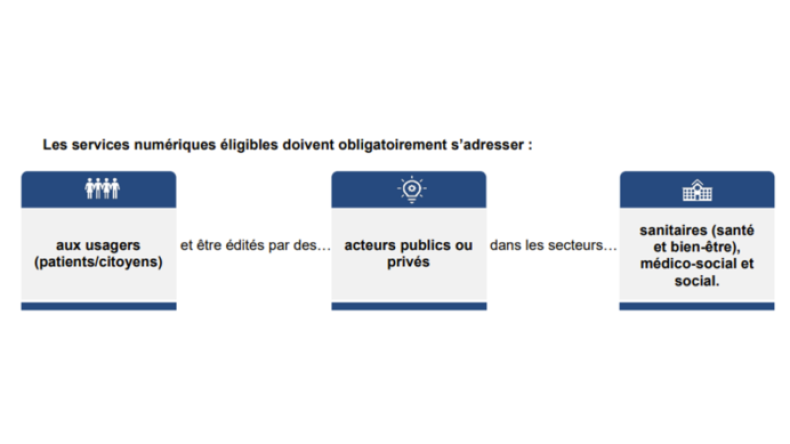Votre question concerne quel type d'offre ?
Votre question concerne quel couloir Ségur ?
Votre question concerne quel dispositif Ségur ?
Votre question concerne quel produit ou service produit?
Votre question concerne quelle thématique ?
In an inclusive way, all digital services aimed at citizens and useful for their healthcare can apply. Eligible services must be for the use of patients/citizens and proposed by public or private actors in the medical (health, wellness), social-medical, or social fields. The services must be included the definition set out by the L. 1111-13-1 bill:
These services may include mobile apps, websites, connected objects, medical devices. They may be free services or not.
Services in the realm of the EU regulation 2017/745 relating to medical devices must be conform to security and performance requirements. If your solution passes the conformity requirements, it will receive the CE label for medical devices.

Cette réponse vous a-t-elle été utile ?
The service is only available for foreign patients that meet the following criteria:
- the patient must come from an EU country providing the Sesali service;
- the patient must have activated the service (depending on their country);
- the patient must have a medical summary in file in their country’s systems.
The list of eligible nationalities is available on the Sesali.fr homepage.
Cette réponse vous a-t-elle été utile ?
Health CERT operates on weekdays between 9am and 6pm. Aside from these working hours, it is possible to contact the ANSSI to signal risks.
CERT Santé
+33 (0)9 72 43 91 25
Agence du Numérique en Santé
9 rue George Pitard, 75015 Paris
Cette réponse vous a-t-elle été utile ?
Yes. The ANS has a video platform with training material, including cybersecurity support. You will find information about cybersuveillance auditing, how to signal a security risk, how to increase your password security, and how to identity malicious email.
Cette réponse vous a-t-elle été utile ?
It is compulsory to have an individual CPx-type card to log in to the INSi teleservice. Three types of cards are supported: CPS, CPE, CPF.
Cette réponse vous a-t-elle été utile ?
CPx cards issued before December 2020 have a contactless chip that prevents from overwriting its code.
The new CPS R3V3 cards that are now in circulation have a Mifare Desfire chip. These cards can stock crypto-secret keys that work with the Mifare Desfire protocol.
All the information about this feature is available in the Manual to deploy contactless CPx cards (available to download below). One must be cautious about the data inserted in the chip’s writing code.
We strongly advise against using this section of the chip to stock access rights. The ANS recommends you to use the ANSSI guidelines on using a "transparent" reader in connected mode. This does not involve a cryptographic protocol during a badge authentication – only the UTL (logic treatment unit) takes part in the cryptographic protocol.
ANSSI advises against setting up a “smart” badge allowing a double authentication breaking from the UTL.
All the recommendations on securing systems for physical access and video projection are available in the document below, "Recommendations on securing systems for physical and video projection access".
Cette réponse vous a-t-elle été utile ?
The MSSanté network system creates a Secure Space, which is managed by the ANS. This Secure Space includes messaging service providers under contract with the Agency (health structures, operators, administrators, etc.) in order to secure globally the electronic messaging services proposed to health professionals. There are many messaging services integrated to the Secure Space, which protects the sharing of health data.
Cette réponse vous a-t-elle été utile ?
Healthcare industrials and software publishers are encouraged to contact Health CERT if they discover a security incident or potential malware. CERT provides assistance and support to resolve such issues. CERT also assists you in your communications to health structures.
Cette réponse vous a-t-elle été utile ?
MSSanté is a secure messaging system that enables authorised professional to share sensitive patient data in a safe manner, in the context of the patient’s care monitoring. As of now, billing and invoicing data are not included in this perimeter.
Cette réponse vous a-t-elle été utile ?
Access to the service may be restricted for the following reasons:
- you do not specialise in occupational medicine
- you work for a private insurance company
- you no longer practise
- your CPS card has expired or been revoked
- your web browser is not compatible
- you are using a mobile appliance (smartphone or tablet)
- you are not included in the following list of health professionals:
- general practitioners and specialists (radiologists, biologists, independent, employee, Samu-Emergencies-C.15, interns)
- biological pharmacists and interns
- pharmacists in dispensaries or hospitals
- dental surgeon, interns
- midwives
- nurses
- physical therapist
- pedicure-podiatrists
- speech therapists
- ergotherapists, psychomotor specialists, orthopists, dieticians
- medical radiologists
Cette réponse vous a-t-elle été utile ?
This midware allows the interfacing between computer applications, such as the Vivoptim doctors portal and the CPS card.
Cette réponse vous a-t-elle été utile ?
MSSanté is an umbrella term which refers to the network of secure messaging services dedicated to healthcare, integrated in a Secure Space. Mailiz is one of the messaging services that is part of this Secure Space, which is managed by the ANS and proposed to health professionals by the Ordres de Santé (Health Governing Bodies).
Cette réponse vous a-t-elle été utile ?
In order for your service to be referenced in the My Health Space database, it must comply with the eHealth doctrine.
The doctrine is re-edited each year and defines the base rules of good practice for security, interoperability, and ethics applicable to eHealth services.
Cette réponse vous a-t-elle été utile ?
My Health Space includes the following health data:
- The medical profile entered by the patient, in an unstructured format (preconditions, allergies);
- Health measurements (weight, height, BMI, temperature, waist size, heart rate, blood pressure, glycemic index, level of pain) in FHIR format;
- Health documents (for example: test and diagnosis results, hospitalisation reports, medical treatments).
Cette réponse vous a-t-elle été utile ?


